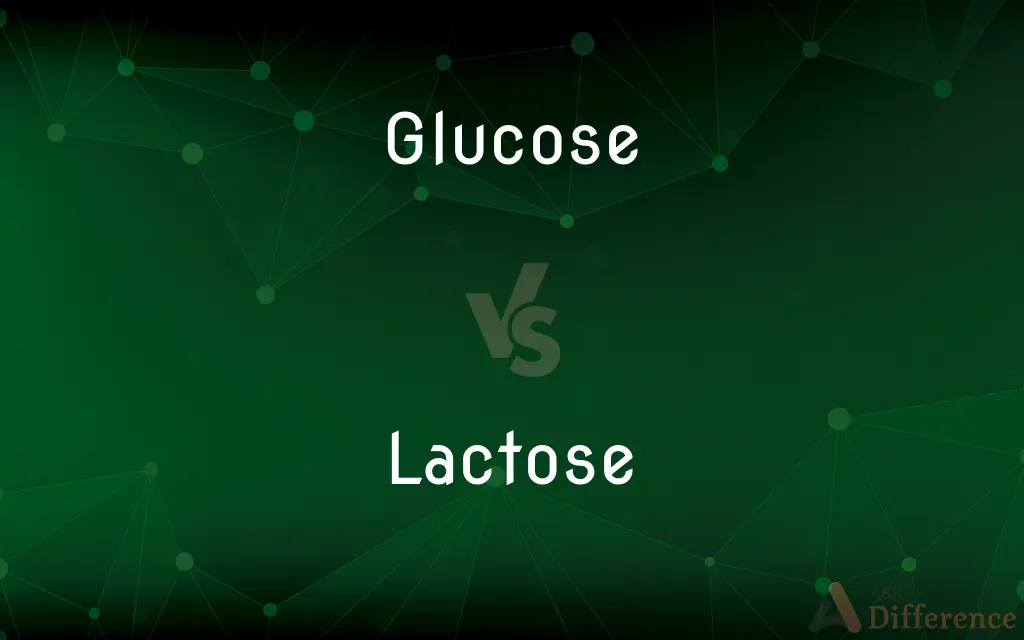Glucose vs. Lactose — What's the Difference?
By Urooj Arif & Maham Liaqat — Updated on March 28, 2024
Glucose is a simple sugar and a key source of energy for cells, while lactose is a disaccharide found in milk, composed of glucose and galactose.

Difference Between Glucose and Lactose
Table of Contents
ADVERTISEMENT
Key Differences
Glucose, a monosaccharide, serves as a crucial energy source for living organisms. It is directly involved in cellular respiration, providing immediate energy. Lactose, on the other hand, is a disaccharide that must be broken down into glucose and galactose before it can be utilized by the body, making its energy provision indirect and dependent on enzymatic digestion.
In terms of dietary sources, glucose is found in a wide range of foods, both as a free sugar and as a building block of more complex carbohydrates. Lactose is primarily found in dairy products, such as milk, cheese, and yogurt, making its consumption more limited to these sources.
The role of glucose in the body extends beyond energy provision; it is also fundamental in synthesizing other vital substances and in metabolic pathways. Lactose’s role is more specialized, primarily serving as a carbohydrate source in the diets of infants and young mammals, including humans, promoting the absorption of calcium and other minerals.
For individuals with lactose intolerance, the consumption of lactose can lead to symptoms like bloating, gas, and diarrhea due to the incomplete digestion of lactose. Since glucose is a simpler sugar, it does not cause such issues when consumed, assuming normal metabolic processes.
Comparison Chart
Type
Monosaccharide
Disaccharide
ADVERTISEMENT
Composition
Single sugar molecule.
Composed of glucose and galactose.
Dietary Sources
Broad (fruits, vegetables, sweets).
Dairy products (milk, cheese, yogurt).
Digestion
Direct absorption.
Requires breakdown by lactase enzyme.
Role in Body
Primary energy source, metabolic processes.
Energy source, promotes calcium absorption.
Common Issues
Rare, unless in excess (hyperglycemia).
Lactose intolerance, digestive discomfort.
Compare with Definitions
Glucose
A simple sugar that is an essential energy source.
Glucose is critical for cellular respiration and energy.
Lactose
Requires the enzyme lactase to break down into glucose and galactose.
Lactose intolerance results from a deficiency in lactase.
Glucose
Directly utilized for energy and metabolic pathways.
Glucose is vital for the synthesis of ATP in cells.
Lactose
A disaccharide sugar found in milk and dairy products.
Lactose gives milk its slightly sweet taste.
Glucose
Essential for life, but imbalances can lead to diabetes.
Monitoring glucose levels is crucial for diabetes management.
Lactose
Mainly found in dairy products.
Milk, cheese, and yogurt are primary sources of lactose.
Glucose
Found in a variety of foods, including fruits and honey.
Apples and bananas are rich in natural glucose.
Lactose
Important for infants and contributes to calcium absorption.
Lactose aids in the dietary intake of essential minerals for bone health.
Glucose
Glucose is a simple sugar with the molecular formula C6H12O6. Glucose is the most abundant monosaccharide, a subcategory of carbohydrates.
Lactose
Can cause digestive issues for those with lactose intolerance.
Consuming lactose without sufficient lactase can lead to gastrointestinal distress.
Glucose
A simple sugar which is an important energy source in living organisms and is a component of many carbohydrates.
Lactose
Lactose is a disaccharide. It is a sugar composed of galactose and glucose subunits and has the molecular formula C12H22O11.
Glucose
A colorless to yellowish syrupy mixture of dextrose, maltose, and dextrins containing about 20 percent water, used in confectionery, alcoholic fermentation, tanning, and treating tobacco. Also called starch syrup.
Lactose
A white crystalline disaccharide, C12H22O11, found in milk, that may be hydrolyzed to yield glucose and galactose. Refined lactose obtained from whey is used in infant foods, bakery products, confections, and pharmaceuticals as a diluent and excipient. Also called milk sugar.
Glucose
(carbohydrate) A simple monosaccharide (sugar) with a molecular formula of C6H12O6; it is a principle source of energy for cellular metabolism.
Lactose
(carbohydrate) The disaccharide sugar of milk and dairy products, C12H22O11, a product of glucose and galactose used as a food and in medicinal compounds.
Glucose
A variety of sugar occurring in nature very abundantly, as in ripe grapes, and in honey, and produced in great quantities from starch, etc., by the action of heat and acids. It is only about half as sweet as cane sugar. Called also dextrose, grape sugar, diabetic sugar, and starch sugar. See Dextrose.
Lactose
The main sugar present in milk, called also sugar of milk or milk sugar. When isolated pure it is obtained crystalline; it is separable from the whey by evaporation and crystallization. It is a disaccharide with the formula C12H22O11, being chemically 4-(
Glucose
Any one of a large class of sugars, isometric with glucose proper, and including levulose, galactose, etc.
Lactose
See Galactose.
Glucose
A monosaccharide sugar that has several forms; an important source of physiological energy
Lactose
A sugar comprising one glucose molecule linked to a galactose molecule; occurs only in milk;
Cow's milk contains about 4.7% lactose
Common Curiosities
What is glucose?
Glucose is a simple sugar, vital for energy production in living organisms.
How are glucose and lactose digested?
Glucose is absorbed directly, while lactose must be broken down by lactase into glucose and galactose.
Why is glucose important for the body?
It's a primary energy source, crucial for cellular functions and metabolic processes.
What is lactose?
Lactose is a disaccharide sugar present in milk, composed of glucose and galactose.
Can everyone digest lactose effectively?
No, people with lactose intolerance lack enough lactase, leading to digestive problems.
How can lactose intolerance be managed?
By consuming lactose-free dairy options, taking lactase supplements, or avoiding lactose-containing foods.
What are the health implications of consuming glucose and lactose?
Consuming glucose is generally safe, but excess can lead to issues like hyperglycemia. Lactose can cause discomfort for those with lactose intolerance.
Are there any dietary restrictions related to lactose?
Yes, individuals with lactose intolerance may need to limit or avoid dairy products.
What role does lactose play in infant nutrition?
Lactose is important in infant diets, supporting growth and the absorption of calcium and other minerals.
Is glucose found only in sugary foods?
No, glucose is also present in fruits, vegetables, and many carbohydrate-rich foods, not just sweets.
Share Your Discovery

Previous Comparison
Emphasize vs. Focus
Next Comparison
Acetanilide vs. AmideAuthor Spotlight
Written by
Urooj ArifUrooj is a skilled content writer at Ask Difference, known for her exceptional ability to simplify complex topics into engaging and informative content. With a passion for research and a flair for clear, concise writing, she consistently delivers articles that resonate with our diverse audience.
Co-written by
Maham Liaqat













































